
Your hosting provider is more than just a place to upload your website files — it’s the foundation your entire online presence depends on.
Whether you’re launching a new project or looking to scale, choosing the right web hosting service largely defines your site’s speed, security, and your peace of mind. It is one of the most important decisions for any website owner.
But with so many options out there, how do you know which one fits your business best?
In this article, we’ll walk you through how to choose web hosting—what really matters and how to find the right partner for your site. Let’s dive in!
Why Your Hosting Choice Matters
Your web hosting provider plays a crucial role in your website’s success. It affects:
- How fast your site loads
- How often it’s available
- How well it ranks on search engines
- How likely visitors are to convert into customers
A reliable web hosting company gives your business a strong technical backbone – one that supports your growth instead of holding it back. Fast speeds, secure infrastructure, and high uptime help keep your audience happy and your business online.
On the flip side, choosing the wrong web hosting service can lead to slow performance, frequent downtime, and security issues. That means lost traffic, missed opportunities, and hours of troubleshooting you shouldn’t have to deal with.
Key Factors to Consider When Choosing a Hosting Partner
Not all hosts are created equal. Whether you’re choosing shared hosting, Cloud hosting, or managed WordPress hosting, your needs will determine the best web hosting provider for you.
The right choice depends on your business — but there are some essential features every reliable provider should offer. Let’s walk through the most important ones.
1. Reliability and Uptime
Your website is your digital storefront — and just like a physical store, it needs to be open when people show up. That’s where uptime comes in.
Uptime refers to the percentage of time your site is live and accessible. Most hosting providers claim to guarantee around 99.9% uptime, which roughly translates into about 40 minutes of total potential downtime per month. Don’t rely on marketing claims alone. Uptime is one of the clearest indicators of a web host’s reliability. Reputable hosts publish a Service Level Agreement (SLA) that clearly outlines their uptime commitment — and whether they offer compensation if that promise isn’t met.
✅ Tip: Look for 99.9% or higher uptime, a transparent SLA, and a global network of data centers with built-in redundancy.
2. Speed and Performance
Website speed isn’t just a technical metric — it’s a competitive advantage. A few extra milliseconds of load time might not sound like much, but for your visitors, it is the difference between staying or bouncing, converting or abandoning.
Let’s look at why speed matters so much — and what hosting features actually move the needle.
2.1. How a Fast Website Drives Better Business Results
A faster website leads to better results across the board — from traffic and conversions to long-term customer satisfaction. Here’s how:
- Higher Search Rankings
Google uses speed as a ranking factor. Sites that load faster get prioritized in search results, especially on mobile. - Better User Experience
Today’s users expect instant access. If your site takes more than a couple of seconds to load, many visitors will leave before they even see your content. - Lower Bounce Rates
Slow pages cause visitors to leave quickly. Faster sites encourage browsing, increase time on site, and reduce bounce rates. - Increased Conversions
Whether you’re selling products, generating leads, or booking consultations, speed has a direct impact on your website conversion rate. Even beyond cached pages, critical conversion actions — like adding a product to the cart or completing a checkout — rely on real-time server responses. These actions aren’t cached, so they depend entirely on the speed of your hosting platform – right when you need it most. - Trust and Professionalism
Users associate speed with quality. A fast, responsive site builds trust and shows that your business is reliable and well-managed.
📊 Industry insight:
According to Google research, as page load time increases from 1 second to 3 seconds, the probability of a visitor bouncing increases by 32%. At 5 seconds, that jumps to 90%.
Other studies found that improving site speed by just 0.1 seconds can increase conversion rates by up to 8% for eCommerce websites.
2.2. What Makes a Host Fast — Features That Matter
Your hosting provider is the engine behind your site’s performance. The right setup can cut seconds off load time and offer consistent speed, even during traffic spikes. Here’s what to look for:
- Modern server infrastructure
- Server-Side Caching
- Content Delivery Network (CDN)
- Optimized Server Stack
Let’s take a closer look at what these features actually mean in practice — and why they matter so much for real-world performance.
Speed starts at the infrastructure level. At SiteGround, we host all websites on the Google Cloud Platform, known for its ultra-fast network, SSD-based persistent storage, and global data center footprint. This means your website runs on cutting-edge infrastructure — not just fast drives, but an entire ecosystem built for performance, scalability, and low latency worldwide.
Server-side caching stores pre-built versions of your pages, so visitors get content instantly — without waiting for the server to generate it from scratch. SiteGround includes multiple layers of caching (static, dynamic, and object) that are automatically configured for most popular platforms.
Content Delivery Networks (CDNs) reduce latency for global visitors by delivering your content from the server nearest to them. SiteGround’s custom, in‑house CDN delivers content from multiple global locations seamlessly—no manual setup required.
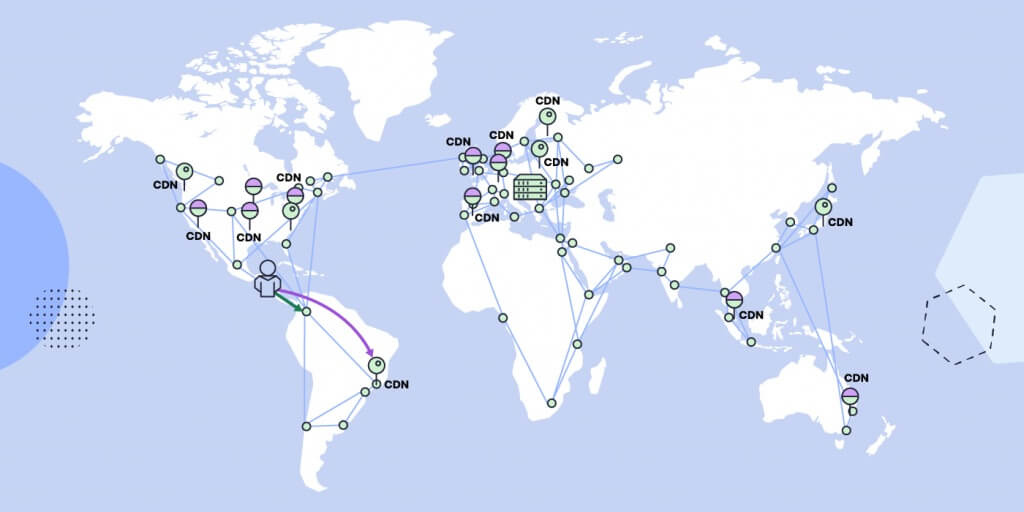
An optimized server stack makes sure all layers — from your web server to your PHP engine and database — are running as efficiently as possible.
For example, SiteGround doesn’t just use standard software like NGINX or PHP — we write our own custom solutions to fine-tune them. Our custom MySQL setup and proprietary Ultrafast PHP are engineered from our expert in-house team to reduce server response times and handle traffic spikes much more efficiently than the default configurations you would normally get.
✅ Pro Tip: Don’t just rely on specs — test them. Use tools like Google PageSpeed Insights or GTmetrix to measure how different hosts perform in real-world conditions.
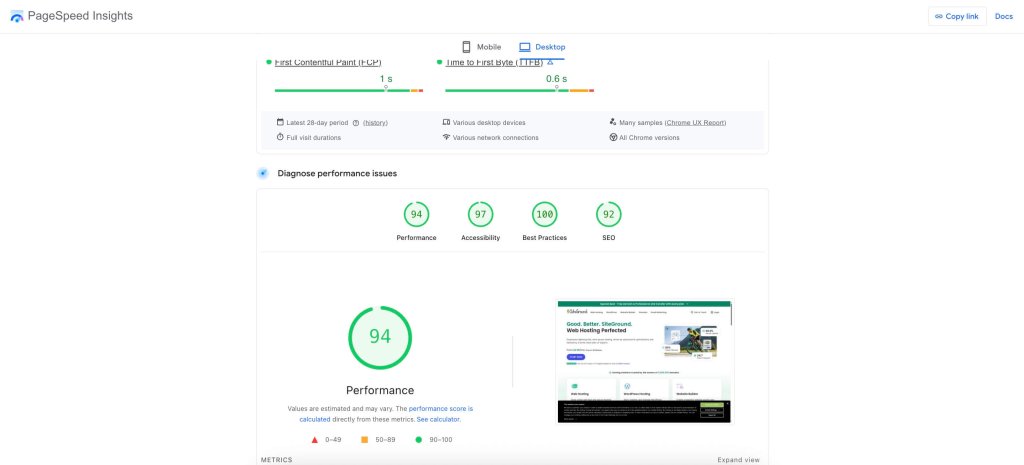
3. Security and Data Protection
Security isn’t just a technical detail — it’s the foundation of trust between your website and your visitors. Whether you run a blog, an online store, or a client portal, your hosting partner should be proactive in protecting your data and your users.
One of the first layers of protection is an SSL, which encrypts the connection between your site and its visitors. Your hosting provider should offer a free SSL certificate (like Let’s Encrypt) and make installation effortless.
At SiteGround, we automatically install an SSL certificate as soon as your domain is pointed to our servers.
But that’s just the beginning.
A robust web hosting platform also includes a Web Application Firewall (WAF). This system filters out malicious traffic, blocking common attacks like SQL injections and cross-site scripting (XSS) before they can reach your website.
Another crucial line of defense is DDoS protection. Distributed Denial of Service attacks flood a site with traffic to take it offline. A good host uses automated systems to detect and mitigate these attacks in real time — often with tiered protections based on the severity and scale.
Some providers even offer Always Online modes to keep a cached version of your site available during disruptions.
Malware protection is also an important layer of security. Hosting providers should scan for malicious code regularly and notify you if a threat is found. It’s even better if additional tools and services are available for more advanced malware scanning and removal — especially useful for high-traffic or business-critical websites.
Another important factor, especially in shared hosting environments, is account isolation. One vulnerable site can put others at risk — unless proper safeguards are in place.
With the right setup, each website on a shared server operates in its own secure space. This prevents malware or exploits from spreading between accounts on the same server.
SiteGround was one of the first companies to implement technologies such as chroot isolation and suEXEC, which set the standard for secure shared hosting.
Today, account isolation remains a best practice for reducing cross-site risk and maintaining a safe, stable environment for everyone on the server.
At SiteGround, a dedicated security team actively monitors for emerging threats and zero-day vulnerabilities. When issues arise, we apply custom security patches across our infrastructure and software — often way before official vulnerability fixes are widely available. This proactive approach helps keep your site safe, even from the latest and most dangerous exploits.
Additional safeguards like Two-Factor Authentication (2FA) for your hosting dashboard, automatic patching for system vulnerabilities, and 24/7 threat monitoring all contribute to a strong security stack.
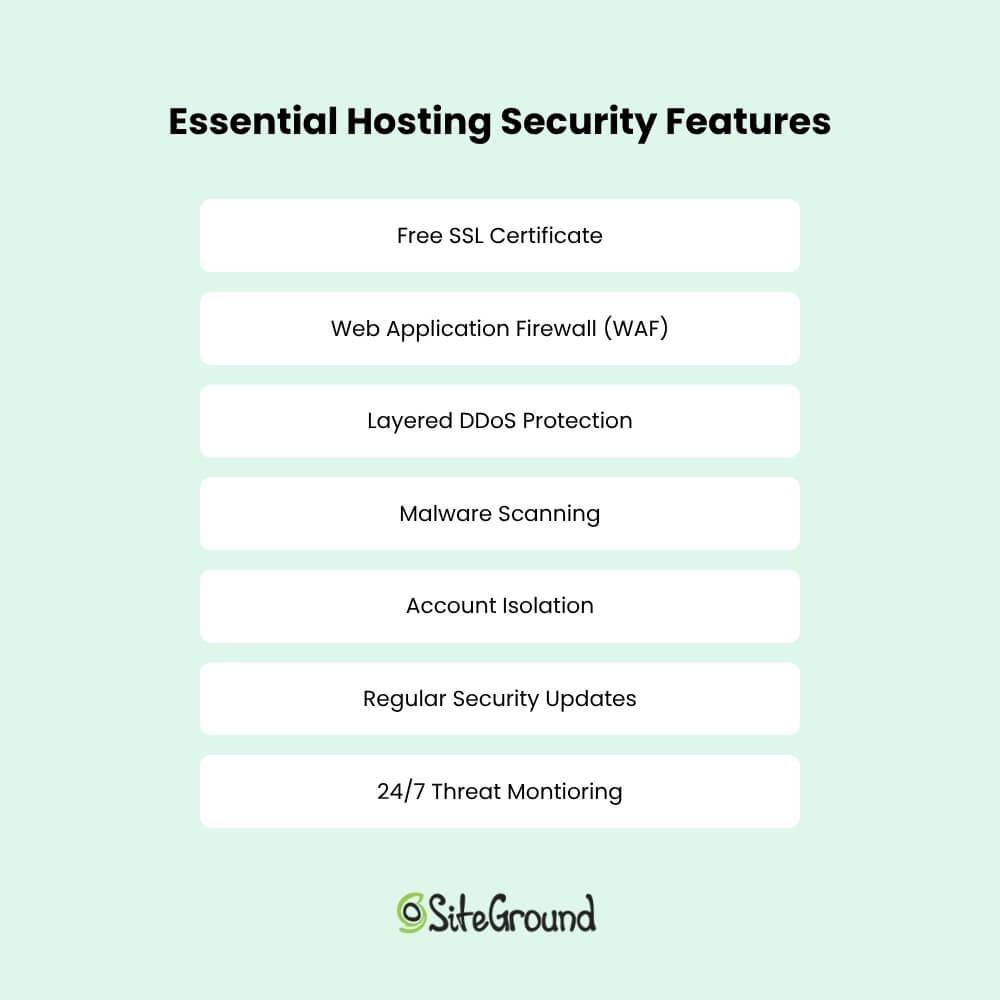
4. Backups
No matter how careful you are, things can go wrong — a plugin update that breaks your site, an accidental file deletion, human error, or even a malware infection. That’s why backups are non-negotiable. Your hosting provider should make it easy to recover your site quickly, with minimal stress or downtime.
A solid backup system includes automated daily backups stored securely, preferably on a separate server. Ideally, these backups should be kept for a minimum of 7–30 days, giving you a comfortable window to roll back changes if needed.
However, even when automatic backups are provided, many hosts store them on the same account or server. This isn’t ideal, as it consumes your website’s resources and creates a single point of failure. If your account or server experiences an issue, your backup stored in the same location would also be compromised.
That’s why at SiteGround, we take a more resilient approach. Instead of utilizing the same server, or another server in the same data center, we store backups across geographically separate data centers — a method known as geo-distributed backups.
This adds an essential layer of protection against events that affect more than just your server — including full data center outages caused by natural disasters or other large-scale failures. SiteGround is one, if not the only, provider that offers daily geo-distributed backups at no extra cost – an essential reliability feature the majority of the hosting companies simply do not have because it’s costly and technically complex to execute — but we consider it a must for keeping your data truly secure.
And then, automation isn’t everything. You should also be able to create manual backups on demand — for example, before making major updates or experimenting with new features. The process should be quick and require zero technical know-how.
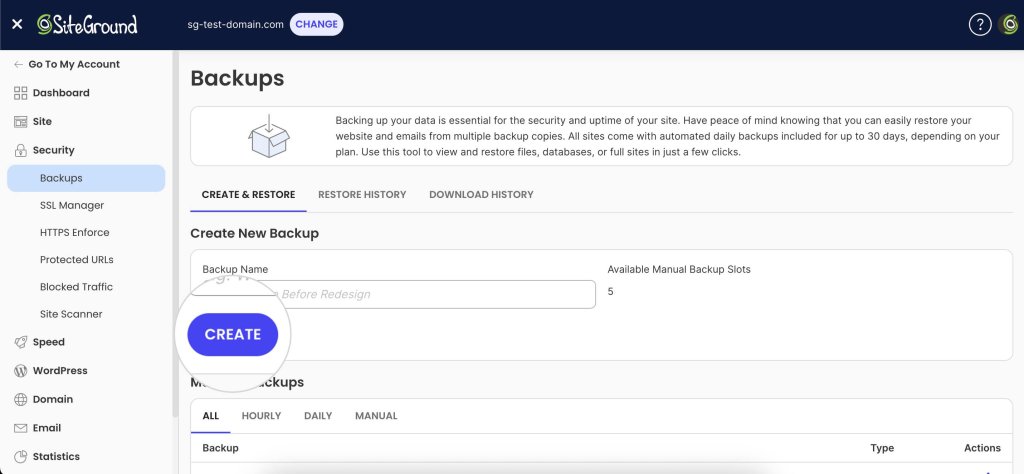
Flexibility matters too. Whether you want to restore your entire site or just a specific file, folder, or database, your hosting partner should give you control over what gets restored and when.
One last thing: restore access. Some hosts limit how often you can restore your backups, or charge extra for it. Others include free backup restores as part of their service — no strings attached.
SiteGround checks all the boxes when it comes to dependable backups — daily automated copies, easy manual triggers, fast restores, and secure geographically-distributed storage are included in all plans.
5. Support and Customer Service
No matter how intuitive a web hosting platform is, there will come a time when you need help — fast. Whether it’s a sudden technical issue or just a quick question about settings, reliable customer support can save you time, stress, and even lost revenue.
Great hosting support isn’t just about being available 24/7 (though that’s important). It’s about getting help from real people who actually know what they’re doing — not just reading from a script.
For business owners without a technical background, access to expert human support is often the difference between resolving an issue in minutes or spending hours searching forums.
Here’s what to look for in a quality support experience:
- 24/7 Availability – Issues don’t follow business hours. Your host’s support shouldn’t either.
- Multiple Contact Channels – Live chat is ideal for quick questions, while support tickets are better for in-depth technical problems.
- Fast Response Times – It’s not just about getting a reply — it’s about getting a useful, timely solution.
- Knowledgeable Staff – Real hosting expertise makes troubleshooting smoother and less frustrating.
Tip: Before you commit, check third-party review platforms like Trustpilot, G2, or Reddit for honest feedback on the host’s support quality.
Fact: SiteGround is often recognized for top-rated support — our team combines technical expertise with a personal touch across chat, ticket and phone. This makes us a favorite among SMBs and agencies.
6. Scalability
Your hosting needs today may not be the same a year from now — and a good hosting partner makes sure you don’t outgrow their platform.
Scalability means being able to upgrade your hosting as your site traffic, functionality, or business complexity grows.
Maybe you start with a simple shared plan, but eventually need the power of cloud hosting. The transition should be smooth, fast, and — most importantly — without downtime.
A scalable host offers:
- Clear upgrade paths, like moving from shared to cloud.
- Flexible limits, so you can add more resources as needed.
- Staging environments to safely test changes before deploying them live.
This flexibility is especially useful for seasonal businesses, growing agencies, or eCommerce sites preparing for big traffic spikes.
A scalable host grows with your business — without painful migrations, or need to start over. At SiteGround you can easily upgrade or downgrade your plan any time, and pay pro-rated whenever needed.
7. Ease of Use and Tools for Business Owners
Not every business owner has a web developer on call — and they shouldn’t need one just to manage hosting. That’s why ease of use is a key factor when choosing a hosting partner.
Your host should provide a clean, intuitive dashboard where you can manage your website, domains, email accounts, and backups without digging through complex menus.
Whether you’re updating DNS records or creating a staging copy of your site, the process should be clear and guided.
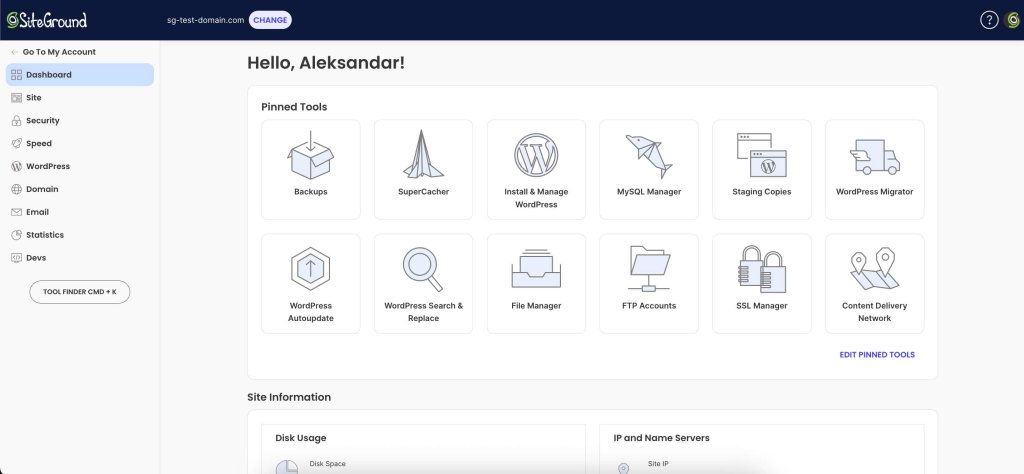
Beyond the basics, look for tools and services that help you run your business more efficiently, such as:
- Email hosting so you can create branded addresses like you@yourdomain.com.
- Free domain registration so you can easily manage your services in one place.
- Website builders for quick and easy site creation without coding.
- eCommerce and analytics integrations to help you sell products and track performance.
- Email marketing tools so you can engage your target audience.
These save time and reduce the need to juggle third-party services.
8. Pricing Transparency and Value
Hosting prices can be tricky. What looks like a great deal up front may come with hidden fees, unexpected renewal rates, or missing features that cost extra later. That’s why transparent pricing matters just as much as the price itself.
Many hosting providers charge extra for essentials like site migration, backups, SSL certificates, or even support.
When comparing providers, go beyond the sticker price. Ask:
- What features are included by default?
- What types of hosting are available?
- Are backups, security features, or email hosting extra?
- How much is the renewal rate, and is it stated on the website?
A trustworthy host makes this information easy to find. They focus on delivering long-term value, not just short-term discounts. Choose based on what you’re getting — not just what you’re paying. Quality infrastructure, support, and tools pay off over time.
How to Research and Compare Hosting Providers
Choosing a hosting partner isn’t something you want to rush. Even if all providers look similar on the surface, what you get behind the scenes can vary a lot. Taking a bit of time to compare your options can save you money, downtime, and future headaches.
Here’s how to make a smart, informed decision:
1. Read Trusted Reviews
Don’t rely solely on testimonials on the host’s own site — check independent platforms like Trustpilot, G2 or Reddit.
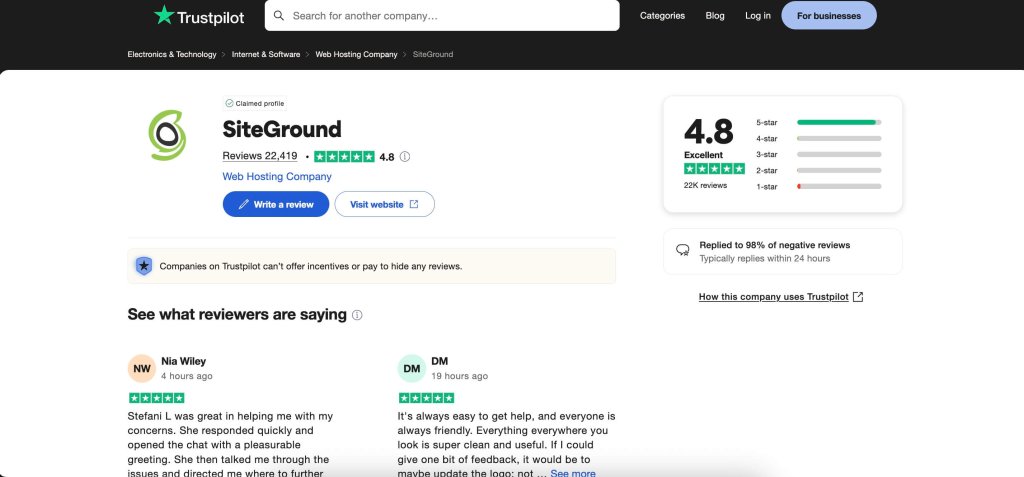
Look for patterns in reviews: Are there frequent complaints about speed, support, or billing? Or do users praise the provider’s reliability and customer service?
To help you compare, here’s how leading hosting providers are rated on Trustpilot based on thousands of customer reviews.
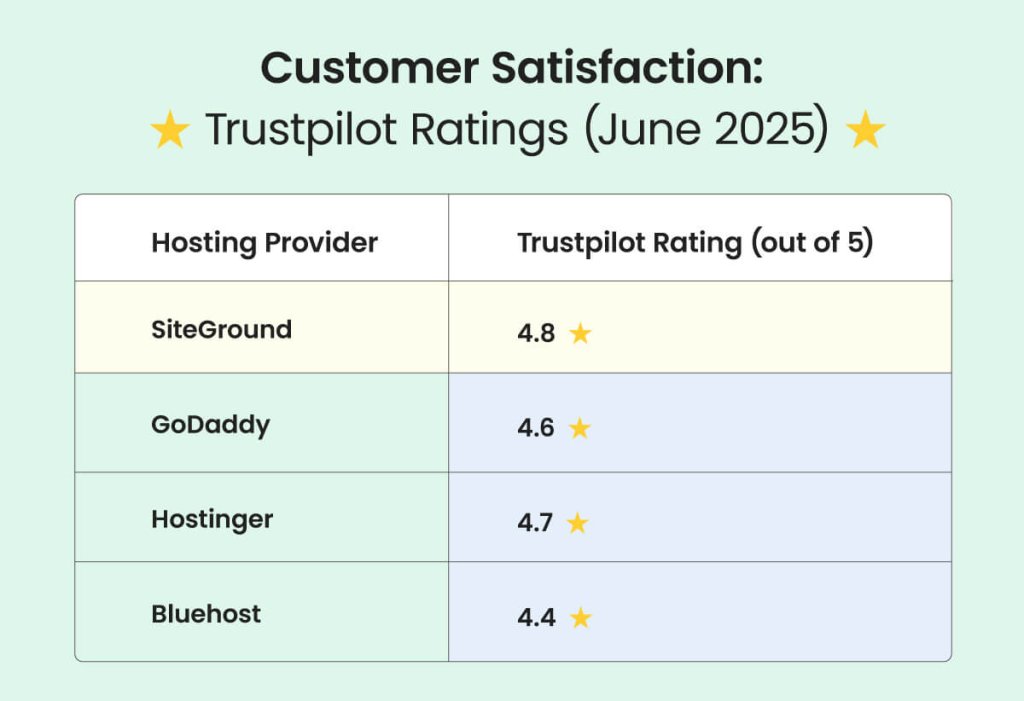
2. Ask Around
Talk to your network — business owners, developers, or agency partners. People with real-world experience can offer valuable insight into what a host is really like to work with day to day.
3. Try Before You Buy
Many providers offer money-back guarantees, trial periods or a demo. Take advantage of these to test the dashboard, run a speed check, or contact support with a few basic questions.
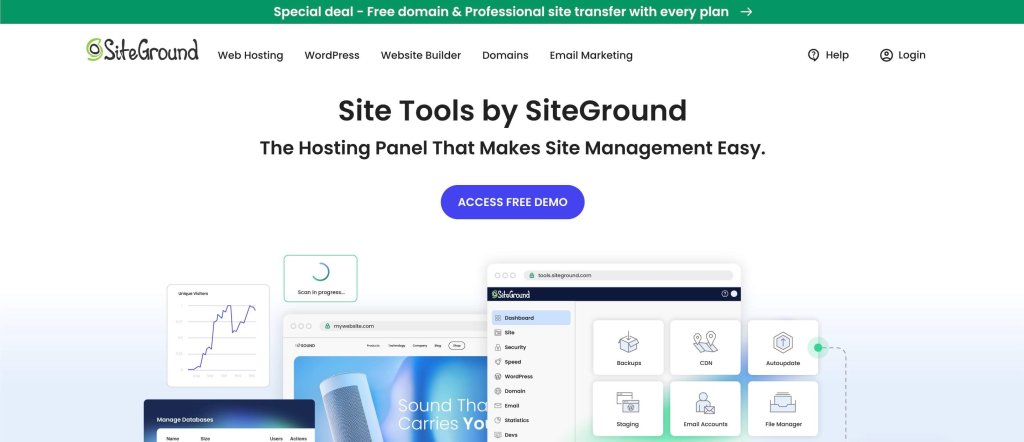
4. Evaluate Transparency
Trustworthy hosts are upfront about what’s included and what’s not. Check their website for clear policies on pricing, uptime, support access, and terms of service. You should be able to understand what you’re paying for — without squinting at the fine print.
Website Hosting Speed Comparison – Real-website Performance Before and After Transferring to SiteGround
Speed isn’t just a feature — it’s a foundational part of your website’s success. At SiteGround, we continuously monitor performance metrics like Time to First Byte (TTFB) across thousands of real websites that migrate from other hosting providers to our platform.
The table below shows aggregated performance results for websites that migrated to SiteGround in 2025. In nearly every case, the majority of sites saw significantly faster load times — particularly when it comes to server responsiveness (TTFB).
Note: This data is based on SiteGround’s internal analysis of real customer migrations and reflects average performance across comparable site setups.
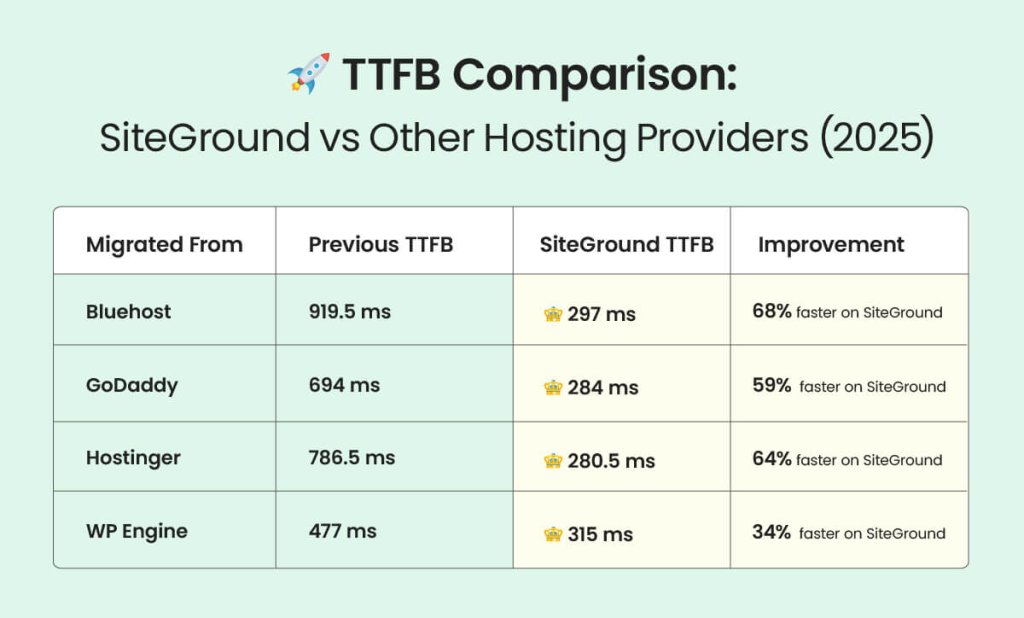
While it is a key performance metric, TTFB only tells part of the story. It only captures the time until the first byte of data is received from your server. From there on, depending on your website size, setup, and configuration, there are multiple elements that need to load – so the actual loading time for your whole website to be displayed varies enormously.
That’s why it’s important to look at real-time speed results. The stats below represent real website data of websites migrated to SiteGround from other hosting providers.
Here is a comparison of real page load times of all actual websites we have confirmed are migrated from these providers to all companies part of the SiteGround group between January 1st 2025 and June 1st 2025 using the automated SiteGround WordPress Migrator plugin.
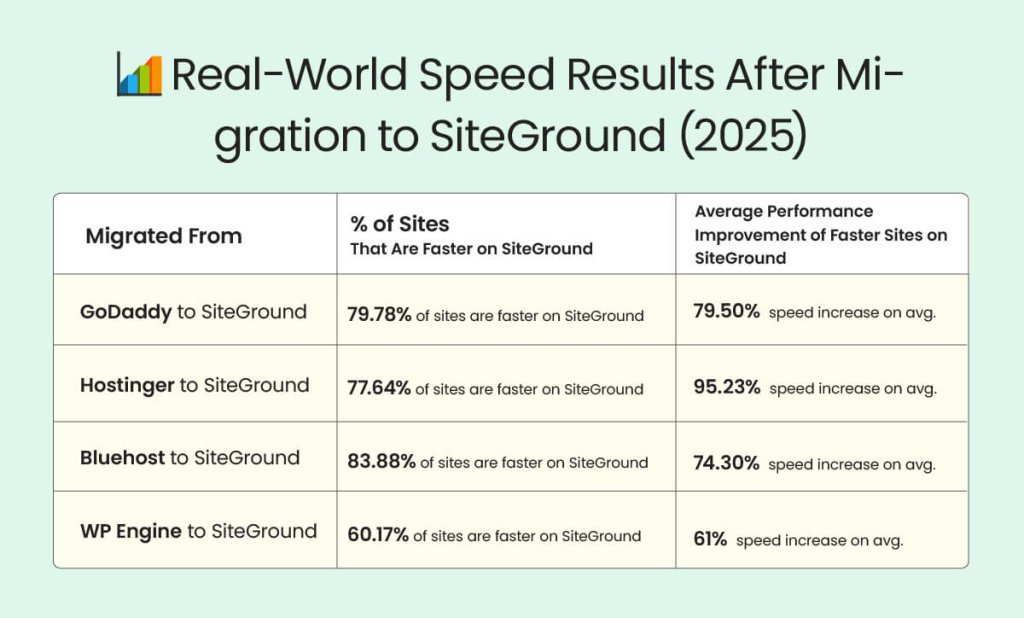
These results reflect what many users already report: after moving to SiteGround, their websites load faster, feel more responsive, and perform better — both for visitors and for search engines.
For a detailed side-by-side view, check out our in-depth comparisons with other hosting providers:
SiteGround vs. Hostinger
SiteGround vs. GoDaddy
SiteGround vs. Bluehost
Power Your Growth with the Right Host
Choosing the right web hosting provider is key to your online success. Focus on reliability, security, support, and scalability — not just price.
Take your time to research, compare, and test providers to find the one that fits your business needs best.
Remember, a good host doesn’t just store your website — it helps your business grow.
Ready to find a hosting partner that checks all the boxes?



Comments ( 0 )
Thanks! Your comment will be held for moderation and will be shortly published, if it is related to this blog article. Comments for support inquiries or issues will not be published, if you have such please report it through our official channels of communication.
Leave a comment
Thanks! Your comment will be held for moderation and will be shortly published, if it is related to this blog article. Comments for support inquiries or issues will not be published, if you have such please report it through our official channels of communication.